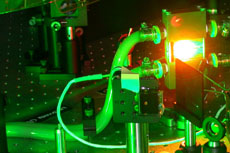
One way to elucidate the function of part of a system is to disrupt and break that part and observe the effect. Using molecular biology tools, this method has led to a better understanding of the genetic origins of many diseases through studies of knock-out and knock-in transgenic animals, for example. While such genetic manipulation technologies are very advanced, techniques for physical disruption, especially of very fine-scale or difficult to access structures, remain crude. Development of technologies that allow specifically targeted structures to be disrupted with sub-micrometer spatial precision, without significant collateral effects, and in native, in vivo environments would open the door to a variety of studies that could match the impact transgenic experiments have had.
Femtosecond laser pulses have the unique capability to deposit energy into a microscopic volume in the bulk of a transparent material without affecting the surface of the material. Here we propose to develop and use this capability to disrupt specifically targeted structures in live cells and animals with the goal of elucidating function and modeling disease states. When a femtosecond laser pulse is tightly focused into a biological tissue, the intensity in the focal volume can become high enough to drive nonlinear optical processes. In particular, laser energy can be deposited into the focal volume of a material that is normally transparent to the laser wavelength through the nonlinear absorption mechanisms of multiphoton and avalanche ionization. This energy deposition is restricted to the focus where the laser intensity is high and leads to the vaporization of the material in the focal volume. While the energy density in the focal volume is sufficiently high to vaporize material, the total energy deposited is very small, so that as this energy diffuses out of the focal volume it has little effect on the surrounding tissue, and collateral damage is minimized. Targeted disruption with a three-dimensional spatial precision of a few hundred nanometers up to a millimeter beneath the surface of a biological tissue with virtually no collateral damage to surrounding structures should be achievable.
As work to optimize laser parameters, beam delivery methods, and pulse manipulation schemes to achieve the best possible precision and penetration. In parallel with this technology development, our studies focus on the use of femtosecond laser disruption to answer pressing scientific questions in several areas, including development of methods for targeted gene transfection through laser poration of cell membranes, determination of the neural wiring that encodes behavior in small animals, and the production of animal models of cerebrovascular diseases. Critically, studies in this collaboration will span biological scales, from disruption of sub-cellular structures in cell culture, to in vivo ablation of cellular and sub-cellular features in small organisms and mammals, to pre-clinical evaluation of laser-based therapeutic strategies of relevance for human disease. This work is carried out by a team that includes experts on femtosecond laser physics and laser/material interactions as well as experts on cell biology, neurobiology, and pathology. This broad approach to the development of femtosecond laser disruption will allow us to fully explore the capabilities and limitations of this technology as a tool to fill the scientific need for precise, targeted physical disruption of biological structures.